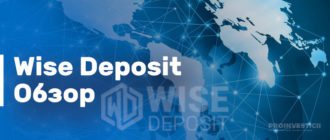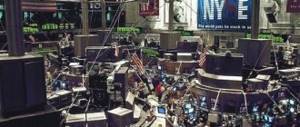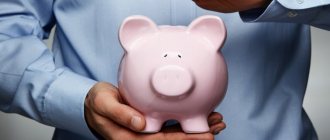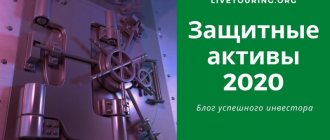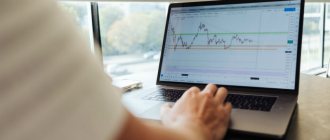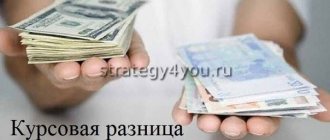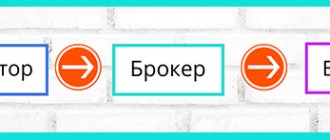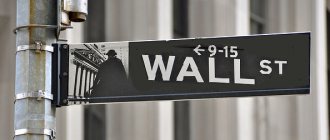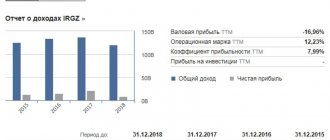Beginning investors and all those who are just getting acquainted with the world of financial markets are faced with such features of the behavior of shares and their prices in exchange trading, which in some cases defy logical explanation or are simply incomprehensible.
In reality, this is partly true, and such “cunning” of the market cannot be explained by unambiguous definitions, as, for example, in mathematics. The thing is that a share as a security has several properties that one way or another manifest themselves on the stock market in the form of price jumps up or down.
The main factors that determine how much a particular stock or bond is currently worth is its connection with both internal causes and events occurring within the issuing company (that is, who issued the share for circulation on the stock market), and with external ones. Such as, for example, events in politics and economics, the fear of some investors and the greed of others. All this together determines the rather complex picture that develops under the influence of diverse and sometimes hidden from the eyes of an ordinary person reasons. A typical mistake of novice investors and traders is that they try to immediately comprehend all the mechanisms of stock pricing in the market, which, as practice shows, is not always easy and also requires some analytical experience and knowledge. In general, in order to invest in the market and make money on it, it is best for beginners to simply know the main reasons why the stock price is such, what factors are most important, and build their trading or investment strategy based on this.
This article will talk about the seven main reasons that cause stocks to rise in the market, and the situations in which you should be especially careful when you see a rising price chart, since each rise has its own reasons and may not always be “real” or objective.
Electronic Arts shares collapsed due to the loss of the license of a popular football club in FIFA 20
In one of the most recent cases, shares of the game developer Electronic Arts collapsed due to the loss of the license to use the name and image of the Italian Juventus kit.
This team is a multiple champion of Italy, and what is even more important is that it features one of the main stars of world football, Cristiano Ronaldo. In the new version of the simulator, Juventus received the fictitious name Piemonte Calcio. On the day this became known, the company's shares lost 4% of their value. The reason for this could be that investors did not understand the scale of the problem. Many of them probably thought that with the loss of the Juventus brand, Ronaldo would also disappear from the game - and for his army of fans this would put an end to the entire simulator. However, in fact, EA retained the rights to use the real rosters of the Italian league teams, so only the name of the team and its uniform have changed. Therefore, subsequently, the share price corrected:
Changing future leadership
Most public companies hold a conference call after they release earnings. During this call, management may make forecasts or provide other guidance regarding the company's future prospects. Investors should be aware that any guidance contrary to the expectations of the investment community could have a material impact on the share price.
Investors should try to participate in the conference call or at least listen to the replay, which is often made available on the company's website an hour or two after the initial call takes place.
(See Conference Calling Basics for more information about these meetings.)
The rise and fall of Nintendo shares in the wake of the popularity of Pokemon GO
Everyone remembers the wild success of the mobile game Pokemon GO.
In the minds of fans of the game and the entire Pokemon universe, the project’s connection with Nintendo turned out to be very strong - and with the growing popularity of the game, the corporation’s shares began to rise in price. The value of Nintendo securities increased by 50% in less than a week, and the total trading volume exceeded $10 billion. An interesting point was that The Pokemon Company and Niantic were developing the game - these are the names that appear on the start screens of the application. Nintendo also participated in the project, but its share did not exceed 32%.
Pokemon GO app
Ultimately, the management of the Japanese company was forced to publicly declare that Nintendo was not developing the game. Soon after this, investors who “learned the truth” began a total sell-off of shares, which led to a drop in their value by 30%. Thus, Nintendo's capitalization still remained in the black based on the results of this story.
Sale by a major shareholder
Some institutional shareholders aim to sell their shares at a given price or upon the occurrence of a certain event. The end result is that the supply of available-for-sale shares (after the event is disclosed) usually reduces the share price.
How can the average investor determine whether a large shareholder is losing his position? The answer can be found in the individual trading volumes on the tape (or in the time and sales reports).
For example, while individual investors typically trade in hundreds or small thousands of shares, institutions such as mutual funds often sell stocks in the tens of thousands of shares—or, even quickly, in small volumes of 3,000 or 4,000 shares.
Take a look at the data and try to determine whether institutional selling is actually driving down the share price. Once the sale is completed, assuming the company's fundamentals remain intact, the share price will often bounce back up quite quickly. This creates an excellent buying opportunity for the long-term investor.
(For more information, read Institutional Investors and the Basics: Which Link?)
DI Corporation shares soar due to Gangnam Style video
In October 2012, shares of semiconductor test device maker DI Corporation soared more than 800%.
There were no apparent reasons directly related to business for such growth. But there was one that was indirectly connected. As it turned out, the chairman and main shareholder of the company was the father of the singer PSY, who shot that very video with wild popularity. Moreover, the artist himself had a certain number of shares in the company. This turned out to be enough.
Interestingly, as a result of this whole story, the usual return of shares to the original price level in such cases did not occur. For many years after the release of the video, DI Corporation's capitalization remained at a significantly higher level than before, although some price correction occurred.
Investors mistakenly bought shares of a random company after Google's takeover of startup Nest
A few years ago, Google made a pretty big deal - it acquired a startup developing smart thermostats and other components of smart home systems called Nest.
The transaction amount was $3.2 billion, and this also aroused great interest in the company’s activities and developments. As a result, investors who had not heard this name yesterday, in the hope that the value of Nest shares would rise, bought so many of them that the securities rose by 1900%. The problem is that the startup Google bought, Nest Labs, was a private company and did not issue shares for trading on the stock exchange. All this time, people were buying shares of a random company - the ticker symbol NEST referred to the company Nestor Inc. This company developed traffic control systems for government customers.
Moreover, by the time this whole story started, the company had already gone bankrupt and sold all its assets, but its shares could still be bought. And as it turns out, similar surges in the value of these shares have happened before. Even before the Google takeover, NEST shares soared in value by 10,000% following news of the release of a new smoke detection system from Nest Labs.
Ultimately, NEST shares were withdrawn from the exchange, and today such a mistake can no longer be made.
Companies used the word "blockchain" to increase capitalization
From December 2021 to January 2021, statements about rebranding and the launch of a new direction allowed companies that were previously not related to IT to sharply increase their capitalization.
The cryptocurrency market was at its peak back then. in December 2021, the tobacco company Rich Cigars Inc. became Intercontinental Technology, Inc. and announced that it plans to engage in mining, its stock quotes increased by 2233%. The same rebranding was carried out by several other companies from the fields of medicine, construction, food and light industry.
This move helped for a short time. Thus, the shares of the mentioned Rich Cigars Inc, as well as the securities of a number of other companies, fell significantly in price within two weeks after the rebranding.
How can investors protect themselves from such stock price surges?
Unsubstantiated ups and downs in company shares happen periodically.
However, for investors, in general, such events carry more risks than opportunities to earn money. To avoid the temptation to succumb to the sentiments of the crowd and, on the wave of hype, to buy shares of a company, which may soon seriously fall in price, it is necessary to use low-risk investment instruments. These include, for example, structured products or model portfolios. Structured products are different financial instruments collected in a single portfolio. The brokerage company's analysts select them in a certain proportion to ensure either minimal or near-zero risk when investing on the stock exchange.
It works like this: a structured product “collects” assets with low risk and small possible profit and riskier assets, which, under a successful set of circumstances, can bring higher income. The idea is simple - if a risky instrument “does not work” and there is a loss on it, then it will be compensated by the profit from a less risky asset - therefore its volume in the structured product is higher.
For example, 90% of a structured product may be federal loan bonds (OFZ), and 10% shares of a company. This is what a structured product with a capital protection level of 100% might look like:
In turn, a model portfolio is an investment portfolio that consists of several securities selected according to certain characteristics (for example, bonds or shares of one sector of the economy). It is somewhat similar to a structured product, but there are fewer opportunities for risk management, although you can start investing with slightly smaller amounts (tens, rather than a couple of hundred thousand rubles).
Such portfolios are convenient for novice investors who have several tens of thousands of rubles, but have no experience working on the stock exchange, which means there is a high probability of losses when trading independently. Each portfolio has an expected return so that the investor understands how much he can earn.
An example of such a portfolio: a model portfolio of American stocks - the possible return is 23% per annum with a low level of risk. Read more about model portfolios here.
Top stock indices
- Dow Jones Industrial Average (DJIA) is an average of the stock price movements of the 30 largest US industrial corporations. The DJIA is the oldest and most widely used of all stock market indicators. There is also a transport index (The Dow Jones Transportation Average, DJTA) and the Dow Jones Utility Average, DJUA.
- The S&P is published by Standard & Poor's (S&P) in two versions - 500 and 100 stocks. This index is considered more accurate than, for example, the DJIA because it represents the stocks of more corporations. Each company's shares are also weighted by the value of all shares.
- NASDAQ (National Association of Securities Dealers Automated Quotation) provides insight into the situation in the US high-tech market. NASDAQ is one of the three main US stock exchanges (besides AMEX and NYSE). Founded in February 1971 and located in New York. Today, shares of more than five thousand high-tech companies are traded on the NASDAQ exchange. The most well-known indices here are the NASDAQ 100 and NASDAQ Composite.
- DAX (DAX 30) was introduced in 1988, and is now the main stock exchange index in Germany. Its calculation involves the prices of shares of thirty top companies from different sectors of the German economy.
- FTSE (FOOTSIE, “Footsie”). The FTSE 100 Index began calculation on January 3, 1984. Takes into account stock quotes of 100 companies with maximum capitalization and included in the list of the London Stock Exchange (LSE) - the largest stock exchange in Europe, which has been operating since 1801.
- Nikkei is considered the most popular Japanese index. Calculated as the arithmetic average of the stock prices of 225 companies on the Tokyo Stock Exchange.
- The Hang Seng is Hong Kong's main capitalization-weighted index. Calculated based on stock quotes of 33 companies, the capitalization of which is about 70% of the Hong Kong Stock Exchange.
- MICEX and RTS are 2 stock indices that include the 50 most liquid and largest companies in Russia. The index includes such giants as Gazprom, Rosneft, Lukoil, Sberbank, Magnit, etc.
